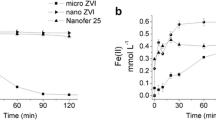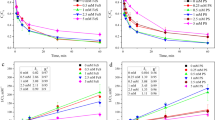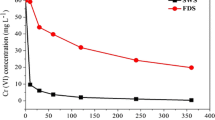Abstract
The presence of antibiotics and their metabolites in natural waters has raised some concern among scientists around the world because it can lead to bacterial resistance and other unknown consequences to mankind and wildlife. Persulfate (PS)-driven oxidation is a new technology that has been used successfully to remediate contaminated sites, but its use to treat wastewater, especially sewage treatment plant (STP) effluent, is still scarce. This paper describes the effect of several persulfate activation methods for degrading sulfathiazole (STZ) in Milli-Q water and in STP effluent. Some parameters, such as pH, persulfate concentration, presence of Mn2+, Zn2+, Cu2+, Fe2+, and Fe3+, as well as copper and iron organic complexes, were studied in STZ degradation. Raising the pH from 5 to 9, as well as the persulfate concentration, resulted in increased STZ degradation. Among the transition metals evaluated, only Fe2+ and Cu2+ were able to activate persulfate molecules. Copper was a better activator than iron since its effect lasts longer. Citrate was the best ligand evaluated increasing Fe(II) activation capacity at pH 7. Hydroxylamine addition to Fe(II) on persulfate system extended the Fe(II) effect. The presence of bicarbonate or humic acid did not affect PS-driven degradation of STZ. Finally, the degradation of STZ in STP effluent promoted by PS-driven oxidation (25 °C) was as fast as in Milli-Q water, proving to be successful.





Similar content being viewed by others
References
Allen TL (1951) The oxidation of oxalate ion by peroxydisulfate1. J Am Chem Soc 73:3589–3593
Anotai J, Bunmahotama W, Lu M-C (2011) Oxidation of aniline with sulfate radicals in the presence of citric acid. Environ Eng Sci 28:207–215. doi:10.1089/ees.2010.0169
Awad YM, Kim S-C, Abd El-Azeem SAM, Kim K-H, Kim K-R, Kim K, Jeon C, Lee SS, Ok YS (2014) Veterinary antibiotics contamination in water, sediment, and soil near a swine manure composting facility. Environ Earth Sci 71:1433–1440. doi:10.1007/s12665-013-2548-z
Ball DL, Crutchfield MM, Edwards JO (1960) The mechanism of the oxidation of 2-propanol by peroxydisulfate ion. J Org Chem 25:1599–1611
Bennedsen LR, Muff J, Søgaard EG (2012) Influence of chloride and carbonates on the reactivity of activated persulfate. Chemosphere 86:1092–1097
Dobson P, Norman JA, Thomas CB (1986) The role of copper (II) salts in the oxidation of aryl-substituted alkenes by peroxydisulphate anion. J Chem Soc [Perkin 1]: 1209–1213
Dong MM, Mezyk SP, Rosario-Ortiz FL (2010) Reactivity of effluent organic matter (EfOM) with hydroxyl radical as a function of molecular weight. Environ Sci Technol 44:5714–5720. doi:10.1021/es1004736
Fan Y, Ji Y, Kong D, Lu J, Zhou Q (2015) Kinetic and mechanistic investigations of the degradation of sulfamethazine in heat-activated persulfate oxidation process. J Hazard Mater 300:39–47. doi:10.1016/j.jhazmat.2015.06.058
Heberer T (2002) Occurrence, fate, and removal of pharmaceutical residues in the aquatic environment: a review of recent research data. Toxicol Lett 131:5–17
Huang K-C, Couttenye RA, Hoag GE (2002) Kinetics of heat-assisted persulfate oxidation of methyl tert-butyl ether (MTBE). Chemosphere 49:413–420
Ji Y, Fan Y, Liu K, Kong D, Lu J (2015) Thermo activated persulfate oxidation of antibiotic sulfamethoxazole and structurally related compounds. Water Res 87:1–9. doi:10.1016/j.watres.2015.09.005
Jørgensen SE, Halling-Sørensen B (2000) Drugs in the environment. Chemosphere 40:691–699
Kim H, Hong Y, Park J, Sharma VK, Cho S (2013) Sulfonamides and tetracyclines in livestock wastewater. Chemosphere 91:888–894. doi:10.1016/j.chemosphere.2013.02.027
Kusk KO, Krüger T, Long M, Taxvig C, Lykkesfeldt AE, Frederiksen H, Andersson A-M, Andersen HR, Hansen KMS, Nellemann C, Bonefeld-Jørgensen EC (2011) Endocrine potency of wastewater: contents of endocrine disrupting chemicals and effects measured by in vivo and in vitro assays. Environ Toxicol Chem 30:413–426. doi:10.1002/etc.385
Liang C, Bruell CJ, Marley MC, Sperry KL (2004) Persulfate oxidation for in situ remediation of TCE. II activated by chelated ferrous ion. Chemosphere 55:1225–1233. doi:10.1016/j.chemosphere.2004.01.030
Liang C, Huang C-F, Chen Y-J (2008) Potential for activated persulfate degradation of BTEX contamination. Water Res 42:4091–4100. doi:10.1016/j.watres.2008.06.022
Liang C, Liang C-P, Chen C-C (2009) pH dependence of persulfate activation by EDTA/Fe(III) for degradation of trichloroethylene. J Contam Hydrol 106:173–182. doi:10.1016/j.jconhyd.2009.02.008
Liang C, Wang Z-S, Bruell CJ (2007) Influence of pH on persulfate oxidation of TCE at ambient temperatures. Chemosphere 66:106–113. doi:10.1016/j.chemosphere.2006.05.026
Mahdi Ahmed M, Barbati S, Doumenq P, Chiron S (2012) Sulfate radical anion oxidation of diclofenac and sulfamethoxazole for water decontamination. Chem Eng J 197:440–447. doi:10.1016/j.cej.2012.05.040
Nie M, Yang Y, Zhang Z, Yan C, Wang X, Li H, Dong W (2014) Degradation of chloramphenicol by thermally activated persulfate in aqueous solution. Chem Eng J 246:373–382. doi:10.1016/j.cej.2014.02.047
Pignatello JJ, Oliveros E, MacKay A (2006) Advanced oxidation processes for organic contaminant destruction based on the Fenton reaction and related chemistry. Crit Rev Environ Sci Technol 36:1–84. doi:10.1080/10643380500326564
Trovó AG, Melo SAS, Nogueira RFP (2008) Photodegradation of the pharmaceuticals amoxicillin, bezafibrate and paracetamol by the photo-Fenton process—application to sewage treatment plant effluent. J Photochem Photobiol Chem 198:215–220. doi:10.1016/j.jphotochem.2008.03.011
Tsitonaki A, Petri B, Crimi M, MosbæK H, Siegrist RL, Bjerg PL (2010) In situ chemical oxidation of contaminated soil and groundwater using persulfate: a review. Crit Rev Environ Sci Technol 40:55–91. doi:10.1080/10643380802039303
Westerhoff P, Mezyk SP, Cooper WJ, Minakata D (2007) Electron pulse radiolysis determination of hydroxyl radical rate constants with Suwannee River fulvic acid and other dissolved organic matter isolates. Environ Sci Technol 41:4640–4646. doi:10.1021/es062529n
Zhang B-T, Zhang Y, Teng Y, Fan M (2015) Sulfate radical and its application in decontamination technologies. Crit Rev Environ Sci Technol 45:1756–1800. doi:10.1080/10643389.2014.970681
Zou J, Ma J, Chen L, Li X, Guan Y, Xie P, Pan C (2013) Rapid acceleration of ferrous iron/peroxymonosulfate oxidation of organic pollutants by promoting Fe(III)/Fe(II) cycle with hydroxylamine. Environ Sci Technol 47:11685–11691. doi:10.1021/es4019145
Author information
Authors and Affiliations
Corresponding author
Additional information
Responsible editor: Gerald Thouand
Electronic supplementary material
ESM 1
(DOCX 22.7 kb)
Rights and permissions
About this article
Cite this article
Velosa, A.C., Nascimento, C.A.O. Evaluation of sulfathiazole degradation by persulfate in Milli-Q water and in effluent of a sewage treatment plant. Environ Sci Pollut Res 24, 6270–6277 (2017). https://doi.org/10.1007/s11356-016-7036-z
Received:
Accepted:
Published:
Issue Date:
DOI: https://doi.org/10.1007/s11356-016-7036-z




